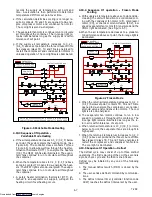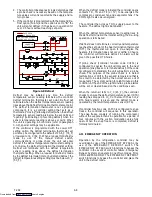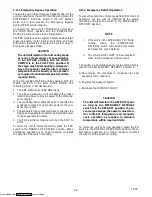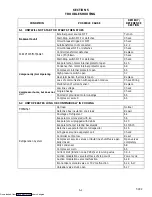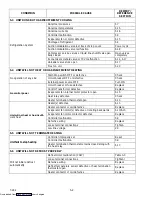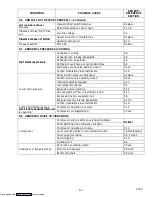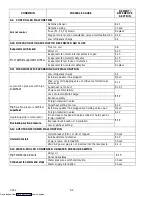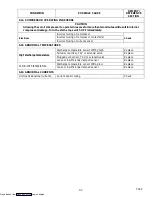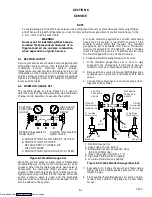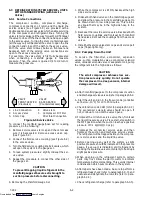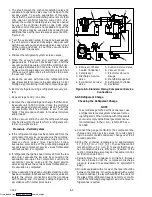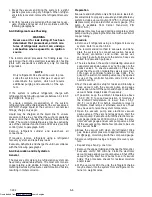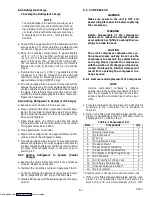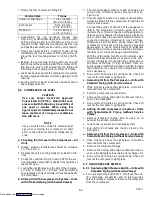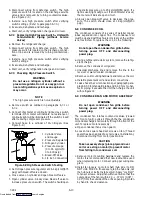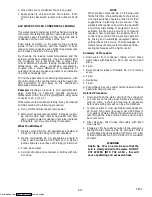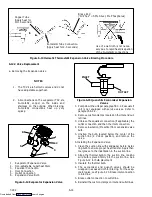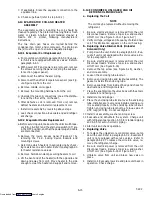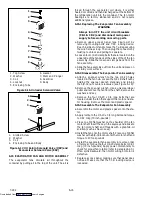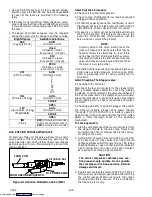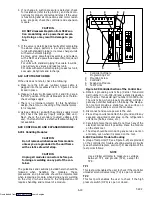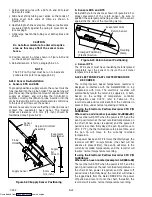
6-7
T-292
6.4.5 Refrigerant Charge
Checking the Refrigerant Charge
NOTE
To avoid damage to the earth’s ozone layer, use
a refrigerant recovery system whenever remov-
ing refrigerant. When working with refrigerants
you must comply with all local government envi-
ronmental laws. In the U.S.A., refer to EPA sec-
tion 608.
a. Connect the gauge manifold to the liquid and suction
access valves. For units operating on a water cooled
condenser, change over to air cooled operation.
b. Bring the container temperature to approximately
--17.8
_
C (0
_
F). Then set the controller set point to
--25
_
C (--13
_
F) to ensure that the suction modulation
valve is fully open. Also, check function code Cd21.
The economizer valve should be open. If ambient is
between 16
_
C (60
_
F) and 49
_
C (120
_
F), proceed to
step d.
c. If ambient is below 16
_
C (60
_
F), partially block the
condenser coil inlet air. Increase the area blocked
until the compressor discharge pressure is raised to
approximately 12 kg/cm
@
(175 psig).
d. On units equipped with a receiver, the level should be
between the glasses. On units equipped with a water
cooled condenser, the level should be at the center of
the glass. If the refrigerant level is not correct, contin-
ue with the following paragraphs to add or remove re-
frigerant as required.
6.4.6 Adding Refrigerant to System (Full Charge)
a. Evacuate unit and leave in deep vacuum.
b. Place cylinder of R-134a on scale and connect charg-
ing line from cylinder to liquid line valve. Purge charg-
ing line at liquid line valve and then note weight of cyl-
inder and refrigerant.
c. Open liquid valve on cylinder and allow the liquid
refrigerant to flow into the unit until the correct amount
of refrigerant has been added.
d. Close liquid valve on cylinder.
e. Start unit in cooling mode. Run approximately 10 min-
utes and check the refrigerant charge.
f. On units equipped with a receiver, the level should be
between the glasses. On units equipped with a water
cooled condenser, the level should be at the center of
the glass. If the refrigerant level is not correct, go to
section 6.4.7.
6.4.7 Adding Refrigerant to System (Partial
Charge)
a. Examine the unit refrigerant system for any evidence
of leaks. Repair as necessary.
b. Maintain the conditions outlined in paragraph 6.4.5.
c. Connect charging line between suction line and cylin-
der of refrigerant R-134a. Open VAPOR valve.
d. Slowly add charge until the liquid appears at the prop-
er level.
6.5 COMPRESSOR
WARNING
Make sure power to the unit is OFF and
power plug disconnected before replacing
the compressor.
WARNING
Before disassembly of the compressor
make sure to relieve the internal pressure
very carefully by slightly loosening the cou-
plings to break the seal.
CAUTION
The scroll compressor achieves low suc-
tion pressure very quickly. Do not use the
compressor to evacuate the system below
zero psig. Never operate the compressor
with the suction or discharge service valves
closed (frontseated). Internal damage will
result from operating the compressor in a
deep vacuum.
6.5.1 Removal and Replacement of Compressor
NOTE
Service compressor contains a nitrogen
charge. Due to the hygroscopic nature of the oil,
time the compressor is left open to the atmo-
sphere should be minimized as much as pos-
sible.
a. Procure a replacement compressor kit. A list of items
contained in the compressor kit is provided in
Table 6-1.
b. If the unit is fitted with standard piping and the com-
pressor is operational, pump the unit down (refer to
paragraph 6.3.2). Skip to step e.
Table 6-1 Compressor Kit
Item
Component
Qty
1
Compressor
1
2
Service Valve Seal
3
3
Mylar Washers
4
4
Wire Tie
2
5
Oil Sight Glass Plug
1
6
Resilient Mount
4
7
Upper Shock Mount Ring
1
8
Upper Shock Mount Bushing
1
9
Compressor Power Plug O--Ring
1
10
SST Washers
8
11
Oil --Mobil 32ST (32 oz can)
2
12
Oil Charge Warning Tag
1
13
Shrader valve/ valve body*
1
14
Mylar Protector
1
* Shrader valve is not used on semi--hermetic units
c. If the unit is fitted with standard piping and the com-
pressor is not operational, turn the unit start--stop
switch (ST) and unit circuit breaker (CB--1) OFF.
Downloaded from
Summary of Contents for 69NT40-531 Series
Page 2: ...Downloaded from ManualsNet com search engine ...
Page 4: ...Downloaded from ManualsNet com search engine ...
Page 8: ...Downloaded from ManualsNet com search engine ...
Page 16: ...Downloaded from ManualsNet com search engine ...
Page 57: ...Downloaded from ManualsNet com search engine ...
Page 104: ...Downloaded from ManualsNet com search engine ...
Page 106: ...7 2 T 292 Figure 7 2 SCHEMATIC DIAGRAM Downloaded from ManualsNet com search engine ...

